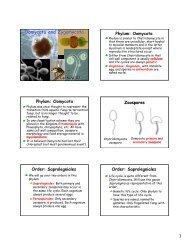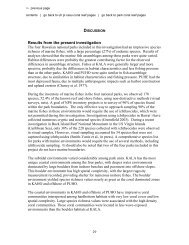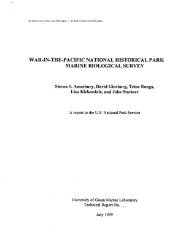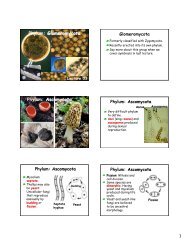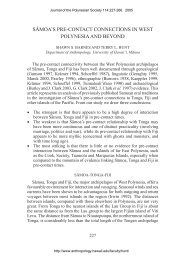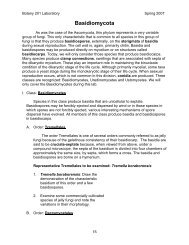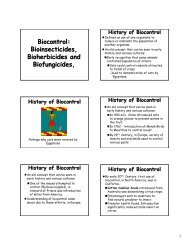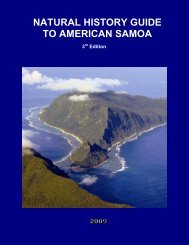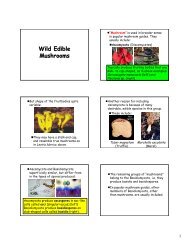american samoa - University of Hawaii at Manoa Botany Department
american samoa - University of Hawaii at Manoa Botany Department
american samoa - University of Hawaii at Manoa Botany Department
- No tags were found...
Create successful ePaper yourself
Turn your PDF publications into a flip-book with our unique Google optimized e-Paper software.
Option 4: Restore Mangrove Forest Upstream <strong>of</strong> the Puna Stream and Tapua Stream MouthsRestor<strong>at</strong>ion <strong>of</strong> the mangrove forest immedi<strong>at</strong>ely upstream <strong>of</strong> the Puna Stream and TapuaStream mouths (Figure 4-3) would initially require the clearing <strong>of</strong> sand, veget<strong>at</strong>ion and solidwaste m<strong>at</strong>erial th<strong>at</strong> presently blocks tidal exchange via the Puna Stream mouth. This effort willrequire clearing within the existing 12-foot wide x 3.5-foot high culvert upstream <strong>of</strong> the Punastream mouth, as well as on the upstream and downstream sides <strong>of</strong> the culvert. A backhoe willalso be needed to facilit<strong>at</strong>e the excav<strong>at</strong>ion <strong>of</strong> sand and heavier solid waste m<strong>at</strong>erial.Machetes and weed-e<strong>at</strong>ers can be used to mow veget<strong>at</strong>ion upstream and downstream <strong>of</strong> theTapua Stream and Puna Stream culverts. Lighter, solid waste m<strong>at</strong>erial should be burned.Excess m<strong>at</strong>erial should be bagged in plastic garbage bags; arrangements should be made withASPA for a special collection <strong>of</strong> this m<strong>at</strong>erial.In November 1999, the double culverts underne<strong>at</strong>h the shoreline vehicular trail were clear <strong>of</strong>any obstructions th<strong>at</strong> might impede tidal exchange via the adjoining Tapua Stream mouth.Consequently, no clearing is anticip<strong>at</strong>ed <strong>at</strong> the Tapua Stream mouth or the upstream culvertunderne<strong>at</strong>h the shoreline trail.The second task <strong>of</strong> the restor<strong>at</strong>ion effort would involve the planting <strong>of</strong> red and orientalmangrove trees within and along the margins <strong>of</strong> the estuary in the fresh-w<strong>at</strong>er swamp, as wellas the banks <strong>of</strong> Tapua Stream and Puna Stream between the culverts and the fresh-w<strong>at</strong>erswamp.Roughly 50 red mangroves should be planted within the streambed because this plant readilycolonizes in estuaries and can sustain itself in w<strong>at</strong>ers with somewh<strong>at</strong> higher salt w<strong>at</strong>erconcentr<strong>at</strong>ions (Stemmermann, 1981). Propagules or seedlings should be plantedapproxim<strong>at</strong>ely three feet apart. Within three years, the mangroves should be thinned to about asix-foot spacing between each plant (Steele, 1999).In contrast, 25 oriental mangroves would more desirably be planted along the stream banksbecause it is less tolerant <strong>of</strong> salt w<strong>at</strong>er. Propagules or seedlings should again be spacedapproxim<strong>at</strong>ely three feet apart. Plants should be thinned to a spacing <strong>of</strong> six feet within aboutthree years.Other smaller trees, shrubs and grasses th<strong>at</strong> can survive successfully in a brackish, estuarineenvironment would supplement mangrove plantings. In-stream plantings <strong>of</strong> red mangrovewithin the estuary, for example, would be supplemented with approxim<strong>at</strong>ely 25 fao trees (beachhibiscus). Along stream banks, the planting <strong>of</strong> oriental mangrove trees would be interspersedwith about 25 milo trees (Thesepesia populnea). Salt resistant grasses would be planted in theestuary to increase the amount <strong>of</strong> available habit<strong>at</strong> <strong>of</strong> fish upstream <strong>of</strong> the Tapua Stream andPuna Stream outlets.Compar<strong>at</strong>ive Benefits and ImpactsPPC’s evalu<strong>at</strong>ion <strong>of</strong> the four altern<strong>at</strong>e restor<strong>at</strong>ion and enhancement str<strong>at</strong>egies is summarized inTable 4-5. Option 4 would achieve significant benefits to wetland veget<strong>at</strong>ion, reduce floodpotential in the vicinity <strong>of</strong> the Puna Stream mouth, expand a fish spawning area in the estuaryupstream <strong>of</strong> the Puna Stream mouth, and cre<strong>at</strong>e new habit<strong>at</strong> for invertebr<strong>at</strong>es. These potentialbenefits can be derived for considerably lower project costs.American Samoa Wetland/Stream Restor<strong>at</strong>ion and Enhancement PlanFebruary 2001, Aoa Wetland, Page 4-12



